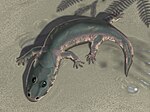Fremouw Formation
| Fremouw Formation | ||
|---|---|---|
Ma | ||
| Type | Approximate paleocoordinates 81°48′S 69°48′E / 81.8°S 69.8°E | |
| Region | Transantarctic Mountains of Antarctica | |
| Type section | ||
| Named for | Fremouw Peak, Queen Alexandra Range, Antarctica.[1] | |
| Named by | P. J. Barrett[1] | |
The Fremouw Formation is a
Stratigraphy
The Fremouw Formation is mostly Triassic in age, with the oldest rocks dating back to the latest
Paleoenvironment

Well-preserved plants are common in the Fremouw Formation. Logs have been found in channel deposits, and roots and stems have been found in
The Fremouw Formation preserves many tetrapod fossils that span the
Biota
The first
Tetrapods
Color key
|
Notes Uncertain or tentative taxa are in small text; |
Temnospondyls
| Taxon | Species | Member | Material | Notes | Images |
|---|---|---|---|---|---|
|
Lower Fremouw |
Jaw fragment, pterygoid bone, and other small fragments |
A |
|||
| Antarctosuchus |
Upper Fremouw |
A mostly complete skull |
A capitosaur temnospondyl
|
||
| Cryobatrachus |
Lower Fremouw |
A partial skull and other bone fragments |
A lydekkerinid temnospondyl
|
||
| Kryostega |
Upper Fremouw |
Large snout fragment |
A stereospondyl temnospondyl
|
||
| Micropholis | M. stowi[11] | Lower Fremouw | A block containing the skeletons of 4 individuals of the taxon, accounting for much of the skeletons. | A Euskelian temnopodyl |  |
| Parotosuchus |
P. sp.[9] |
Upper Fremouw |
Fragment of the right side of the snout. |
A temnospondyl |
|
| Rhigerpeton | R. isbelli[12] | Lower Fremouw | Partial skull | A lapillopsid temnospondyl | |
| Rhytidosteidae |
R. indet.[4] |
Lower Fremouw |
A temnospondyl |
Reptiles
| Taxon | Species | Member | Material | Notes | Images |
|---|---|---|---|---|---|
| Antarctanax |
Lower Fremouw |
Eight presacral vertebrae, left humerus, ribs, feet |
Medium-sized archosauriform |
||
| Archosauriformes | Indeterminate.[14] |
Lower Fremouw |
A large-bodied archosauriform reptile |
||
| Palacrodon |
Lower Fremouw |
An enigmatic diapsid reptile; initially named Fremouwsaurus geludens |
|||
| Procolophon |
Lower Fremouw |
A procolophonid reptile
|
|||
| Prolacerta |
Lower Fremouw |
A prolacertiform reptile
|
Synapsids
| Taxon | Species | Member | Material | Notes | Images |
|---|---|---|---|---|---|
| Cynognathus |
Cynognathus sp.[15] |
Upper Fremouw |
A cynodont
|
||
| Impidens |
Upper Fremouw |
Partial snout |
A cynodont, originally described as Diademodontidae indet.[15] |
 | |
| Ericiolacerta |
Lower Fremouw |
||||
Kannemeyeriidae
|
Indeterminate.[15] |
Upper Fremouw |
A dicynodont
|
||
| Kombuisia | K. antarctica[7] |
Lower Fremouw |
A dicynodont |
||
| Lystrosaurus |
Lower Fremouw |
A dicynodont |
|||
|
Lower Fremouw |
A dicynodont |
||||
| Myosaurus |
Lower Fremouw |
A dicynodont |
|||
| Notictoides | N. absens [19] | A therocephalian | |||
| Pedaeosaurus |
Lower Fremouw |
A therocephalian |
|||
| Rhigosaurus |
Lower Fremouw |
A therocephalian |
|||
| Thrinaxodon |
Lower Fremouw |
A cynodont |
See also
References
- ^ a b Barrett, P.J., 1969, Stratigraphy and petrology of the mainly fluviatile Permian and Triassic Beacon rocks, Beardmore Glacier area, Antarctica. Ohio State University Institute of Polar Studies Report 34, pp1-132 .
- S2CID 10995542.
- ^ S2CID 28006253.
- ^ a b c "Background". Transantarctic Vertebrate Paleontology Project. Augustana College. 2008. Archived from the original on 7 July 2011. Retrieved 13 July 2011.
- ^ a b Taylor, E.L.; Taylor, T.N. (1993). "Fossil tree rings and paleoclimate from the Triassic of Antarctica" (PDF). In Lucas, S.G.; Morales, M. (eds.). The Nonmarine Triassic. Albuquerque: The New Mexico Museum of Natural History and Science Bulletin. pp. 453–455.
- .
- ^ S2CID 20557454.
- ^ hdl:2246/2750.
- ^ .
- .
- ISSN 0272-4634.
- ISSN 0272-4634.
- S2CID 92116260.
- ^ S2CID 129231144.
- ^ .
- S2CID 237517965.
- ^ hdl:2246/5362.
- ^ a b Colbert, E.H. (1974). "Lystrosaurus from Antarctica" (PDF). American Museum Novitates (2535): 1–44.
- ISSN 0272-4634.
- hdl:2246/2011.











